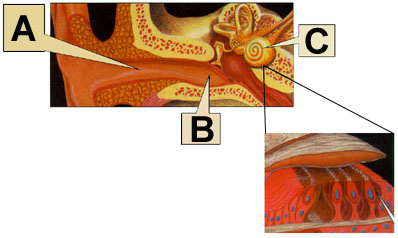Let's follow a sound as
it begins its journey.

Many people mistakenly
believe hearing loss is temporary, that the ears
are "getting used to" noise. In
reality, permanent hearing loss, damage to the COCHLEA,
may be occurring. Some signs of hearing loss
include:
Exposure to high noise
levels can cause hearing loss or impairment. It
can create physical and psychological stress.
There is no cure for noise-induced hearing loss,
so the prevention of excessive noise exposure is
the only way to avoid hearing damage.
Specifically designed protection is required,
depending on the type of noise encountered.
Preformed or molded ear
plugs should be individually fitted by a
professional. Waxed cotton, foam, or fiberglass
wool earplugs are self-forming. When properly
inserted, they work as well as most molded
earplugs.
Some earplugs are
disposable, to be used one time and then thrown
away. The non-disposable type should be cleaned
after each use for proper protection. Plain
cotton is ineffective as protection against
hazardous noise.
Earmuffs need to make a
perfect seal around the ear to be effective.
Glasses, long sideburns, long hair, and facial
movements, such as chewing, can reduce
protection. Special equipment is available for
use with glasses or beards.
For extremely noisy
situations, earplugs should be worn in addition
to earmuffs. When used together earplugs and
earmuffs change the nature of sounds; all sounds
are reduced including one's own voice, both other
voices or warning signals are easier to hear.
For more specific
information on a hearing conservation program see
Title 29 CFR 1910.95 - Occupational Noise
Exposure.
An estimated 10 million
Americans suffer from hearing impairments due to
over-exposure to noise. OSHA standards requires
employers to establish a hearing conservation
program that covers employees exposed to an
8-hour Time-Weighted Average (TWA) sound level of
85 decibels (dB) or greater. A Hearing
Conservation Program must include noise exposure
monitoring, audiometric testing & evaluation,
employee training in the effects of noise &
care of hearing protection devices, and the use
of hearing protectors, where necessary. Proper
record-keeping is also essential.
OSHA requires that
employers measure the noise levels to which their
workers are exposed in their specific work
environment. When workers are exposed to a TWA
noise level of 85 to 90 dB, employers must make
hearing protectors available, but usage is
optional. When the TWA noise level equals or
exceeds 90 dB, hearing protectors must be worn by
all employees. Workers who have experienced a
permanent, significant shift in hearing must wear
hearing protection at TWA noise levels of 85 dB. Consult
OSHA Regulation 29 CFR 1910.95 for additional
requirements.
Because the permissible
exposure limit is a TWA for an 8-hour work day,
workers may be exposed to higher sound levels if
the duration of exposure is less than 8 hours.
OSHA's Permissible Noise Exposures Table (shown
below) lists permissible exposure durations and
the respective maximum permissible noise levels
(when measured on the A scale of a standard sound
level meter at slow response). Occupational noise
exposure should always be evaluated in
conjunction with any significant high-noise
recreational activities.
Noise Reduction Rating
(NRR): The Noise Reduction Rating
is the approximate measure in decibels (dB) of a
hearing protector's ability to reduce your
exposure to sound. All of the earplugs, hearing
bands and earmuffs shown list specific NRRs. Your
choice will depend on how much sound you need to
"attenuage", or reduce to a safe level.
The larger the number, the greater your
protection from hazardous noise.
OSHA Requirements:
OSHA requires noise entering the ear be less than
90 decibels averaged over an eight-hour day. If
noise levels reach or exceed 85 decibels, OSHA
requires employers to implement a "Hearing
Conservation Program" to protect employees
from the effects of noise exposure.



